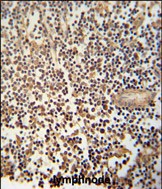MCA1 Antibody (C-term)
Purified Rabbit Polyclonal Antibody (Pab)
- 产品详情
- 实验流程
- 背景知识
Application
| WB, IHC-P, E |
|---|---|
| Primary Accession | Q12904 |
| Other Accession | P31230, O54873 |
| Reactivity | Human |
| Predicted | Hamster, Mouse |
| Host | Rabbit |
| Clonality | Polyclonal |
| Isotype | Rabbit IgG |
| Calculated MW | 34353 Da |
| Antigen Region | 242-268 aa |
| Gene ID | 9255 |
|---|---|
| Other Names | Aminoacyl tRNA synthase complex-interacting multifunctional protein 1, Multisynthase complex auxiliary component p43, Endothelial monocyte-activating polypeptide 2, EMAP-2, Endothelial monocyte-activating polypeptide II, EMAP-II, Small inducible cytokine subfamily E member 1, AIMP1, EMAP2, SCYE1 |
| Target/Specificity | This MCA1 antibody is generated from rabbits immunized with a KLH conjugated synthetic peptide between 242-268 amino acids from the C-terminal region of human MCA1. |
| Dilution | WB~~1:1000 IHC-P~~1:100~500 E~~Use at an assay dependent concentration. |
| Format | Purified polyclonal antibody supplied in PBS with 0.09% (W/V) sodium azide. This antibody is prepared by Saturated Ammonium Sulfate (SAS) precipitation followed by dialysis against PBS. |
| Storage | Maintain refrigerated at 2-8°C for up to 2 weeks. For long term storage store at -20°C in small aliquots to prevent freeze-thaw cycles. |
| Precautions | MCA1 Antibody (C-term) is for research use only and not for use in diagnostic or therapeutic procedures. |
| Name | AIMP1 |
|---|---|
| Synonyms | EMAP2, SCYE1 |
| Function | Non-catalytic component of the multisynthase complex. Stimulates the catalytic activity of cytoplasmic arginyl-tRNA synthase (PubMed:10358004). Binds tRNA. Possesses inflammatory cytokine activity (PubMed:11306575). Negatively regulates TGF-beta signaling through stabilization of SMURF2 by binding to SMURF2 and inhibiting its SMAD7- mediated degradation (By similarity). Involved in glucose homeostasis through induction of glucagon secretion at low glucose levels (By similarity). Promotes dermal fibroblast proliferation and wound repair (PubMed:16472771). Regulates KDELR1-mediated retention of HSP90B1/gp96 in the endoplasmic reticulum (By similarity). Plays a role in angiogenesis by inducing endothelial cell migration at low concentrations and endothelian cell apoptosis at high concentrations (PubMed:12237313). Induces maturation of dendritic cells and monocyte cell adhesion (PubMed:11818442). Modulates endothelial cell responses by degrading HIF-1A through interaction with PSMA7 (PubMed:19362550). |
| Cellular Location | Nucleus. Cytoplasm, cytosol. Secreted. Endoplasmic reticulum {ECO:0000250|UniProtKB:P31230}. Golgi apparatus {ECO:0000250|UniProtKB:P31230}. Note=Enriched in secretory vesicles of pancreatic alpha cells and secreted from the pancreas in response to low glucose levels (By similarity). Secreted in response to hypoxia (PubMed:10850427). Also secreted in response to both apoptotic and necrotic cell death. {ECO:0000250|UniProtKB:P31230, ECO:0000269|PubMed:10850427} |
For Research Use Only. Not For Use In Diagnostic Procedures.
Provided below are standard protocols that you may find useful for product applications.
BACKGROUND
MCA1 is a cytokine that is specifically induced by apoptosis, and it is involved in the control of angiogenesis, inflammation, and wound healing. The release of this cytokine renders the tumor-associated vasculature sensitive to tumor necrosis factor. The precursor protein is identical to the p43 subunit, which is associated with the multi-tRNA synthetase complex, and it modulates aminoacylation activity of tRNA synthetase in normal cells. This protein is also involved in the stimulation of inflammatory responses after proteolytic cleavage in tumor cells.
REFERENCES
Awasthi,N., Lab. Invest. 89 (1), 38-46 (2009)
Sen,E., Clin Lung Cancer 9 (3), 166-170 (2008)
终于等到您。ABCEPTA(百远生物)抗体产品。
点击下方“我要评价 ”按钮提交您的反馈信息,您的反馈和评价是我们最宝贵的财富之一,
我们将在1-3个工作日内处理您的反馈信息。
如有疑问,联系:0512-88856768 tech-china@abcepta.com.























 癌症的基本特征包括细胞增殖、血管生成、迁移、凋亡逃避机制和细胞永生等。找到癌症发生过程中这些通路的关键标记物和对应的抗体用于检测至关重要。
癌症的基本特征包括细胞增殖、血管生成、迁移、凋亡逃避机制和细胞永生等。找到癌症发生过程中这些通路的关键标记物和对应的抗体用于检测至关重要。 为您推荐一个泛素化位点预测神器——泛素化分析工具,可以为您的蛋白的泛素化位点作出预测和评分。
为您推荐一个泛素化位点预测神器——泛素化分析工具,可以为您的蛋白的泛素化位点作出预测和评分。 细胞自噬受体图形绘图工具为你的蛋白的细胞受体结合位点作出预测和评分,识别结合到自噬通路中的蛋白是非常重要的,便于让我们理解自噬在正常生理、病理过程中的作用,如发育、细胞分化、神经退化性疾病、压力条件下、感染和癌症。
细胞自噬受体图形绘图工具为你的蛋白的细胞受体结合位点作出预测和评分,识别结合到自噬通路中的蛋白是非常重要的,便于让我们理解自噬在正常生理、病理过程中的作用,如发育、细胞分化、神经退化性疾病、压力条件下、感染和癌症。








